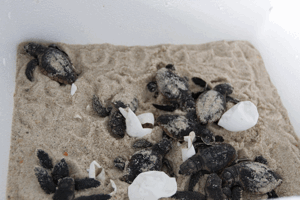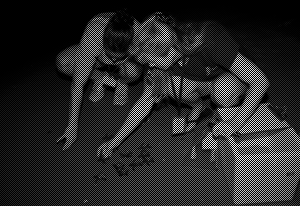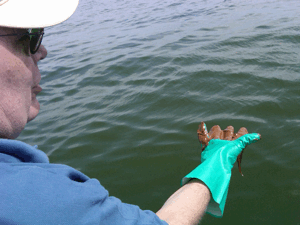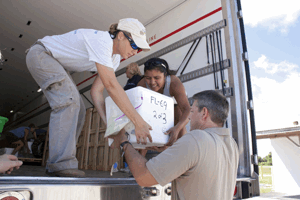Gulf of Mexico Half a Year Later
Air Date: Week of October 15, 2010

Hatchlings emerge from their shells. (Sea Turtle Conservancy)
Six months after the BP blowout began, LOE’s Jeff Young asks scientists what we know so far about the oil’s effects. For some species the direct toll from the oil is less severe than many had feared. But the long-term impacts could mean the worst is yet to come.
Transcript
GELLERMAN: October the 20th marks half a year since the BP oil disaster. The explosion killed eleven workers and before the well was capped some 200 million gallons of oil had gushed into the Gulf of Mexico. Within days the Obama administration imposed a moratorium on deepwater drilling in the Gulf; this past week the feds lifted the ban and imposed much stricter safety rules and regulations on the oil industry.
But much more murky is the state of the Gulf ecosystem. During the disaster we spoke with many wildlife scientists. Now, six months later, Living on Earth’s Jeff Young caught up with some of them to find out how the Gulf is doing.
YOUNG: It was in mid-May when I last spoke with Melanie Driscoll of the Audubon Society’s Louisiana Coastal Initiative. Driscoll walked the beach of Louisiana’s Grand Isle, counting birds and looking for signs of the massive oil slick. She knew then that the ultimate effects would be hard to spot.
DRISCOLL: There’s a saying about ecology that ‘it’s not rocket science, it’s a lot more complicated than that.’

Audubon’s Melanie Driscoll on Grand Isle, La. The oil’s direct impacts were less than she’d feared, but she warns long term effects could still take a toll on some of the nation’s most important bird habitats. (Photo: Jeff Young)
YOUNG: (Laughs.)
DRISCOLL: We’re looking at a system. The birds rely not just on their feathers insulating them, they rely on food chains that are underwater or in the sand. They rely on protection from predators by being familiar with their surroundings, it’s very complicated.
YOUNG: Federal records show that some 95 species of birds were collected from the Gulf coast during the oil blowout. Nearly 7,000 died. And oddly, that’s the good news. Driscoll says she had feared a much higher body count by now.
DRISCOLL: And, what we know now is that the direct effects are much less than they might have been. Fewer birds were oiled and therefore, less death initially. We’re still very concerned, though, about the longer term effects of oil in the food chain, oil in the environment, and that we may not be seeing the effects on their reproduction or their survival for a number of years.
YOUNG: Now, Driscoll is watching the fall migrants. They need the delta’s bounty of insects, worms, and crustaceans to fuel up for the flight south. Driscoll fears that oiled islands and wetlands might still be tainted or simply not offer enough food. So wildlife officials are trying to lure birds away from shore by flooding inland fields, creating new habitat. But, Driscoll says, many species are still drawn to the coast, where they always go. She’s finding the most birds in the spots with the most remnant oil.
DRISCOLL: That’s what we saw at the six month mark was, because these areas are traditionally such good areas for birds, the birds are choosing to be there, even though those are the areas that have the most oil. So we have concerns that they may be having to work harder to fatten up, or they may not fatten up as well- and therefore not be as fit to fly across the Gulf.
YOUNG: Other scientists I spoke with share Driscoll’s mix of relief about the oil’s direct impact and uncertainty about the long-term. Back in early July, groups that work with endangered sea turtles were looking at a dire situation. Turtles were coming ashore to nest just as the oil hit. Sea Turtle Conservancy Director David Godfrey, told us about a daring plan to move the turtle nests.

Hatchlings emerge from their shells. (Sea Turtle Conservancy)
GODFREY: Well, in essence what we are trying to do is save this year’s entire hatchling class of sea turtles from the north Gulf coast of Florida from emerging from their nests and then swimming out into the Gulf to really meet almost certain doom.
YOUNG: Federal and state officials, non-profit groups and volunteers hand-dug some 25,000 eggs and loaded them into special containers. Fed Ex trucks carried them across the Florida peninsula to the oil free waters of the Atlantic. It was unprecedented. And risky. We called Godfrey back to see if it worked.
GODFREY: It did work and it was the right thing to do at the time. The oil conditions were such that we needed to do something to save those hatchlings. A very well orchestrated plan was put in place and we got it right.
YOUNG: About 15,000 hatchlings got a fresh start in the Atlantic. As for the turtles in the Gulf, some 600 dead have been collected. Whether the turtles can bounce back depends largely on how their habitat recovers from the oil.

The first sea turtle hatchlings are released. (Sea Turtle Conservancy)
[BOAT SOUNDS]
YOUNG: In late July, I took a boat trip near the mouth of the Mississippi with National Wildlife Federation Conservation scientist Doug Inkley. Inkley was looking for the floating brown algae, called sargassum. It’s crucial habitat for sea turtle hatchlings, fish larvae and other small creatures.

National Wildlife Federation’s Doug Inkley found oil in the sargassum weed in July. By August fresh sargassum had floated in, greatly improving habitat for baby turtles and fish larvae. (Photo: Jeff Young)
INKLEY: You can see how it’s got a lot of surface area for eggs and larvae to hang on to.
YOUNG: A glob of oil on your hand there.
INKLEY: Oh yeah there is oil coming right out of the sargassum. Every place that we’ve seen sargassum so far we’re seeing the oil in blobs. So everything that’s attracted to sargassum here, is, in essence, being attracted to oil.
YOUNG: Then, rusty brown blobs lurked under the surface as far down as we could see. But, just a little more than a month later. The Sea Turtle Conservancy’s Godfrey found much better conditions.
GODFREY: You know, it was kind of surprising to be honest with you how normal it looked. Healthy mats of sargassum weed had floated in from other areas from the Gulf where they have never been exposed to oil. That sargassum was full of all the sorts of critters- fish, crabs, even found a lot of healthy juvenile turtles in that habitat.

David Godfrey unloads turtle eggs on the Atlantic coast. (Sea Turtle Conservancy)
YOUNG: The surface looks good, Godfrey says, but most of the remaining oil is in the depths, where the effects are harder to measure. Scientists I spoke with say it’s far too early to know what’s happening to deep-sea creatures or animals like the sperm whale, and the bluefin tuna. The government has just started it’s full accounting of the spill’s full impact with what’s called the Natural Resources Damage Assessment, NRDA, as it’s known, can take years. And most researchers compiling that official report can’t talk about their work. All of which means most answers about what happened at the Deepwater Horizon disaster, are still on the distant horizon. For Living
on Earth, I’m Jeff Young.
Links
Audubon report birds 6 months after the spill started
NOAA maps of animal strandings
Sea Turtle Conservancy on turtles and the spill
Some of LOE’s stories on the spill’s impacts: Sea Turtle relocation
Living on Earth wants to hear from you!
Living on Earth
62 Calef Highway, Suite 212
Lee, NH 03861
Telephone: 617-287-4121
E-mail: comments@loe.org
Newsletter [Click here]
Donate to Living on Earth!
Living on Earth is an independent media program and relies entirely on contributions from listeners and institutions supporting public service. Please donate now to preserve an independent environmental voice.
NewsletterLiving on Earth offers a weekly delivery of the show's rundown to your mailbox. Sign up for our newsletter today!
 Sailors For The Sea: Be the change you want to sea.
Sailors For The Sea: Be the change you want to sea.
 The Grantham Foundation for the Protection of the Environment: Committed to protecting and improving the health of the global environment.
The Grantham Foundation for the Protection of the Environment: Committed to protecting and improving the health of the global environment.
 Contribute to Living on Earth and receive, as our gift to you, an archival print of one of Mark Seth Lender's extraordinary wildlife photographs. Follow the link to see Mark's current collection of photographs.
Contribute to Living on Earth and receive, as our gift to you, an archival print of one of Mark Seth Lender's extraordinary wildlife photographs. Follow the link to see Mark's current collection of photographs.
 Buy a signed copy of Mark Seth Lender's book Smeagull the Seagull & support Living on Earth
Buy a signed copy of Mark Seth Lender's book Smeagull the Seagull & support Living on Earth

